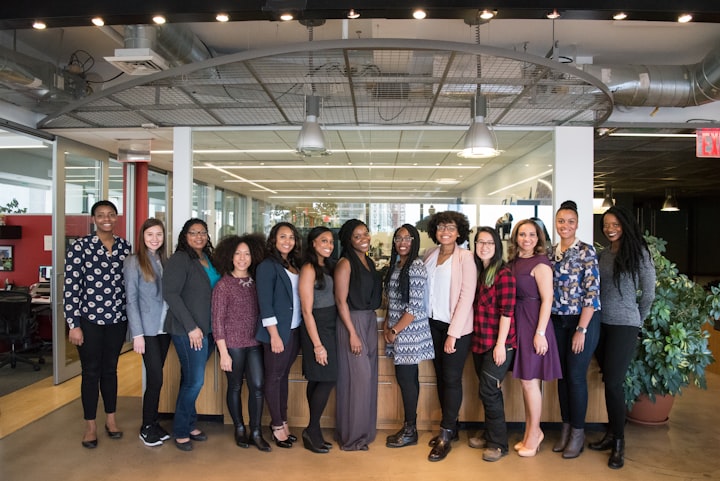
Breaking the Glass Ceiling: Advancing Women in the Workplace"
Breaking the Glass Ceiling" is a term used to describe the invisible barrier that prevents women from advancing to higher-level positions in the workplace. The metaphor of a "glass ceiling" suggests that while women can see the opportunities for advancement above them, they are unable to break through to those positions.
Advancing women in the workplace is an important aspect of achieving gender equality. Women are underrepresented in leadership positions and tend to face discrimination and bias in their careers. This can include obstacles such as a lack of mentorship and networking opportunities, stereotypes and gender bias, and a lack of flexibility in the workplace to accommodate caregiving responsibilities.
To break the glass ceiling, organizations can implement policies and programs that promote diversity and inclusion, provide mentorship and networking opportunities for women, and offer flexible work arrangements. Additionally, raising awareness about unconscious bias and gender discrimination, and actively working to address it, is crucial for creating a more equitable workplace for women.
Equal Pay for Equal Work: Closing the Gender Wage Gap"
Equal Pay for Equal Work" refers to the principle that individuals should be paid the same amount for doing the same job, regardless of their gender. Despite significant progress in recent decades, women still earn less than men on average in many countries. This is often referred to as the "gender wage gap."
The gender wage gap can be caused by a number of factors, including discrimination and bias, a lack of women in higher-paying positions, and differences in the type of work that women and men tend to do. Women are often concentrated in lower-paying jobs and industries, and may be more likely to work part-time or take time out of the workforce to care for children or other family members.
Closing the gender wage gap is important for achieving gender equality and economic security for women. Policies and programs that can help to close the gap include equal pay laws, efforts to increase the representation of women in higher-paying industries and positions, and policies that support work-life balance and reduce discrimination against women.
Additionally, companies can also conduct regular pay analysis, make sure that their hiring and promotion processes are fair and unbiased, and create a culture of transparency around pay. Encouraging more women to pursue careers in science, technology, engineering, and math (STEM) can also help to close the gender wage gap as these fields tend to pay more than others.

Reproductive Rights and Women's Health"
Reproductive rights and women's health refer to the ability of individuals to make informed decisions about their reproductive health, including the right to access safe and legal abortion, contraception, and maternal care.
- Women's reproductive rights are often a contentious issue, with some individuals and groups believing that the government should restrict access to certain reproductive services and others believing that individuals should have autonomy over their own bodies.
- Access to safe and legal abortion is a fundamental aspect of reproductive rights. It allows individuals to make informed decisions about their reproductive health and plan their families. Without access to safe abortion, women are at risk of injury or death from unsafe procedures.
- Contraception is also an important aspect of reproductive rights. It allows individuals to plan their families and prevent unintended pregnancies. Lack of access to contraception can lead to unintended pregnancies and poor maternal health.
- Maternal care is also crucial for reproductive rights, as it ensures that pregnant women receive the necessary medical care to have a healthy pregnancy and delivery.
- Reproductive rights and women's health are essential for gender equality, as they allow women to participate fully in society and make choices about their own lives.
Women in Leadership: The Importance of Representation"
Women in Leadership" refers to the representation of women in leadership positions, such as CEOs, managers, and elected officials. Representation of women in leadership is important because it helps to ensure that women's perspectives and experiences are taken into account in decision-making processes. It also serves as a role model for other women, encouraging them to pursue leadership positions themselves.
The underrepresentation of women in leadership positions is a persistent problem. According to the World Economic Forum, it will take 257 years to close the gender gap in leadership positions. This can be caused by a number of factors, including discrimination and bias, a lack of mentorship and networking opportunities for women, and societal stereotypes about women's abilities and roles.
To increase the representation of women in leadership, organizations can implement policies and programs that promote diversity and inclusion, provide mentorship and networking opportunities for women, and offer flexible work arrangements. Additionally, raising awareness about unconscious bias and gender discrimination, and actively working to address it, is crucial for creating a more equitable workplace for women.
Moreover, having more women in leadership positions is beneficial for organizations, as studies have shown that companies with more women in leadership positions tend to perform better than those with fewer. It also brings diversity in decision making which leads to better results, more creativity and improved customer satisfaction.

Women's Economic Empowerment: The Key to Gender Equality"
Women's economic empowerment refers to the ability of women to fully participate in the economy, control economic resources, and make economic decisions. It is a key aspect of achieving gender equality, as it allows women to have more autonomy and agency in their lives, and can also lead to positive economic outcomes for families and communities.
Economic empowerment for women includes having access to education, job training, and employment opportunities, as well as access to financial resources such as credit and property ownership. Without these opportunities, women are more likely to be confined to low-paying, insecure work, and to have less control over their own lives and the lives of their families.
There are many barriers that can prevent women from achieving economic empowerment, including discrimination and bias, lack of access to education and job training, and cultural and societal norms that limit women's roles and opportunities.
To promote women's economic empowerment, policies and programs can be implemented to increase access to education and job training for women, provide credit and other financial resources to women-owned businesses, and support policies that promote gender equality in the workplace. Additionally, campaigns and programs to change societal norms and attitudes around women's roles and capabilities can also help to promote women's economic empowerment
Overall, women's economic empowerment is a key aspect of achieving gender equality, as it allows women to have greater control over their own lives and contribute to economic development and growth





Comments (1)
Good work Please support me by reading my story: https://vocal.media/lifehack/travel-is-glamorous-4rmuug0g12